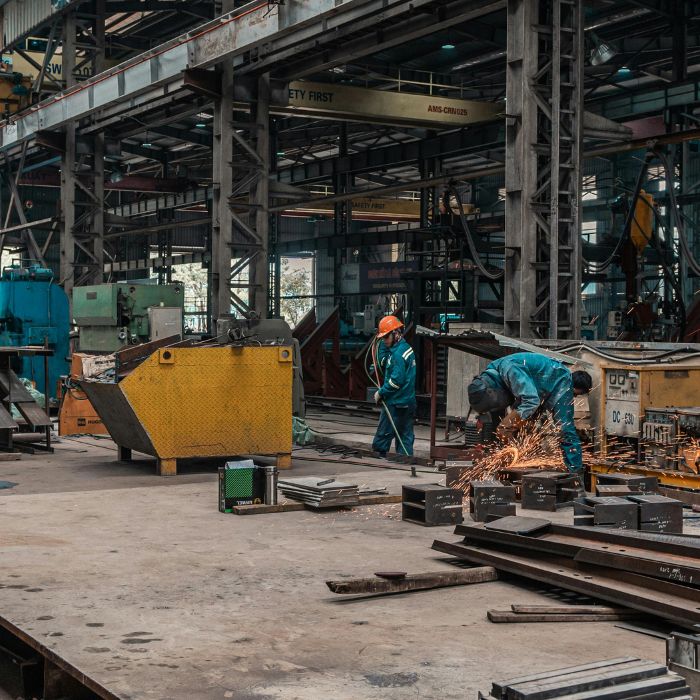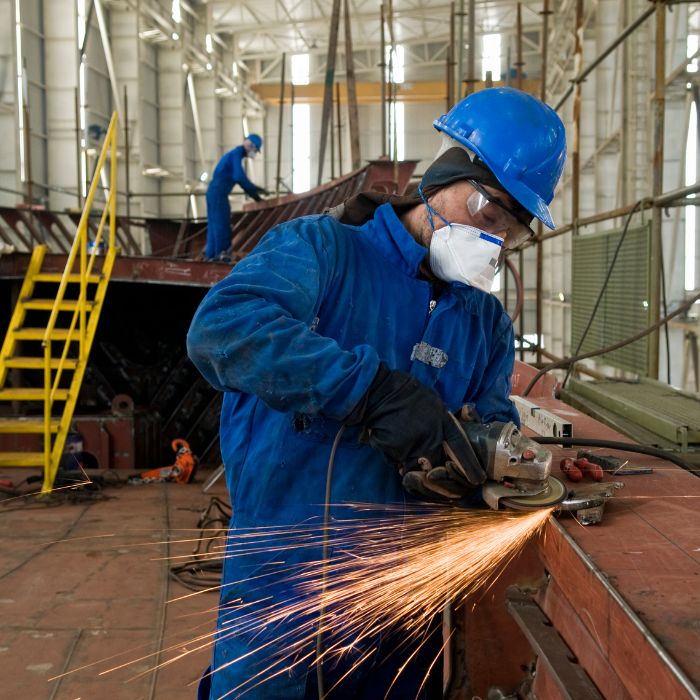Metal Structure Cutting: Technical Guide
How to Use Cutting Discs Effectively and Safely
Cutting metal structures requires precision, control, and, above all, the correct choice of abrasive discs. In a professional setting, this choice is based not only on diameter or brand but also on the technical compatibility between the disc, the machine, and the material being worked on.
For structural profiles such as IPE beams, pipes, or carbon steel sheets, it is recommended to use 115 mm or 125 mm angle grinders equipped with reinforced resin discs, typically 1.0 mm to 3.0 mm thick. Thinner discs allow for fast and clean cuts, ideal for lightweight structures, while thicker discs provide greater stability on high-density sections.

Every disc used for metal cutting must comply with the EN 12413 standard, which regulates safety requirements for bonded abrasive products. This marking, along with the maximum operating speed (in m/s and rpm), the recommended material type, and the direction of rotation, ensures that the product has undergone resistance and dynamic balance testing.
Likewise, the disc’s maximum speed should never be lower than that of the machine, as this could cause breakage during use. A 125 mm grinder, for example, can reach up to 12,250 rpm, which corresponds to a speed of 80 m/s—the limit set for this type of tool.
Finally, professionals should check the physical condition of the disc before mounting it—ensuring there are no cracks, deformations, or moisture—and make sure that the flange and spindle are clean and properly tightened. Incorrect mounting or even a single trapped particle can compromise both the quality of the cut and the operator’s safety.
Workpiece and Workspace Preparation
Before performing any cutting operation on metal structures, preparing both the workspace and the workpiece is just as important as choosing the right disc. Improper handling can cause deviations, vibrations, overheating, or even serious accidents.
1. Securing and Stabilizing the Workpiece
Metal structures often have complex geometries and high levels of inertia. Therefore, it is essential to ensure the stability of the workpiece before cutting.
Recommended steps include:
- Use clamps, vices, or support jacks to prevent movement.
- Avoid leaving the cutting point unsupported, as this could pinch the disc at the end of the operation.
- For beams and pipes, anticipate the direction of internal stress release to prevent the cut line from closing.
For large structures, using auxiliary supports or cutting in phases minimizes the risk of deformation.

2. Controlling the Work Environment
A clean and organized workspace improves both safety and process efficiency.
- Maintain a minimum clearance of 1.5 meters around the operator.
- Remove flammable or spark-sensitive materials.
- Ensure proper ventilation, especially in enclosed spaces, to prevent the accumulation of metal dust or gases.
- Ensure direct lighting over the cutting line.
According to the recommendations of the National Institute for Occupational Safety and Health (INSST, NTP 281), it is also advisable to delimit the work area with barriers or fireproof curtains when working in workshops with multiple operators.

3. Pre-Use Tool Inspection
Before turning on the grinder or angle grinder, the following points should be checked:
- The disc is properly aligned and securely fastened.
- There are no visible cracks or deformations.
- The safety guard is installed and properly positioned.
- The wiring and power switch are functioning correctly.
Only after these checks should a 60-second no-load test be performed, which allows detection of vibrations or defects before the actual cutting.

Step-by-Step Cutting Technique
Making a clean and safe cut on a metal structure requires following a precise work sequence, where stability, speed, and material cooling determine the final result.
1. Marking and Preliminary Layout
Before starting the cut, the exact cutting line should be marked with chalk or a heat-resistant marker. This provides a clear visual guide and minimizes errors as the disc progresses. In structural work, even a small deviation can affect the final assembly or compromise the alignment of welds.
2. Disc Position and Angle
The disc should be held at a 90° angle to the surface being cut. This angle ensures maximum abrasive efficiency and prevents uneven edge wear.
A smaller angle can cause lateral friction, increasing temperature and the risk of disc breakage.
For thick materials or closed profiles, it is advisable to start the cut at the most accessible edge and proceed with a steady, linear motion without forcing the tool. Pressure should be moderate: let the disc do the work through abrasion, not by pushing.
3. Speed and Feed Control
The cutting feed should be kept steady, avoiding sudden movements or excessive pressure.
If a decrease in cutting speed is observed, it may indicate:
- Excessive disc wear.
- Material that is too hard for the type of abrasive.
- Insufficient rotational speed.
In these cases, the operation should be stopped, the disc’s condition checked, and the equipment’s power verified.
4. Thermal Management and Safety
During the cutting of metal structures, the heat generated can cause deformation, discoloration, or loss of temper in the material.
To prevent this, it is recommended to:
- Perform intermittent cuts to allow heat dissipation.
- Avoid prolonged contact of the disc in the same spot.
- Use thin discs (1–1.6 mm) for fast cuts that reduce friction.
For safety, the operator should always remain to the side, never in front of the disc plane, and wear certified eye and face protection.
Regulations and Safety in Spain for Cutting Metal Structures
Cutting with abrasive discs in Spain is regulated by industrial safety standards designed to ensure operator safety and process reliability. Compliance with these standards is not only a legal requirement but also a matter of quality and occupational risk prevention.
EN 12413 Standard and OSA Marking
Every cutting disc must comply with the UNE-EN 12413 standard, which regulates the characteristics of bonded abrasive products. This standard ensures that discs have passed tests for breakage resistance, balance, and durability.
Products with OSA (Organization for the Safety of Abrasives) certification additionally guarantee compliance with the strictest European safety standards.
Occupational Risk Prevention (Royal Decree 1215/1997 and 773/1997)
Royal Decree 1215/1997 requires employers to ensure that the tools used are safe and in proper working condition.
Similarly, Royal Decree 773/1997 mandates the use of personal protective equipment (PPE) whenever there is a risk of flying debris, noise, or vibration.
In the case of cutting metal structures, this PPE includes:
- Safety goggles and a face shield.
- Cut-resistant gloves and flame-resistant clothing.
- Protección auditiva homologada.
- Safety footwear with reinforced toe caps.
Storage and Maintenance Conditions
Abrasive discs should be stored in dry, ventilated areas, away from heat or moisture sources, as these factors can affect their structure.
The INSST Technical Guide recommends keeping discs on flat surfaces, avoiding vertical stacking that could deform them.
Before each use, a visual inspection and a 30-second no-load test should be performed to ensure there are no cracks or abnormal vibrations.
Personnel Training
Finally, worker training is a key aspect. According to the Occupational Risk Prevention Law, every operator must be familiar with:
- The disc’s usage limitations.
- The correct cutting technique.
- Emergency procedures in case of breakage or fire.
Strict adherence to these measures significantly reduces the risk of accidents and increases the efficiency of metal cutting operations.

Recommended Abrasteel Products for Cutting Metal Structures
1. BASIC Line
BASIC discs are designed for fast cutting of steel alloys, combining working speed with good durability.
Ideal for boiler-making workshops, locksmiths, and industrial maintenance, they allow work with a wide range of thicknesses (1 to 3.2 mm) and diameters (115 to 230 mm).

2. TOP Line
Designed for users who require higher performance on stainless steel, this line offers a balance between fine cutting and disc lifespan.
Its A60SXBF abrasive composition ensures a cool cut, reducing the risk of discoloration or edge deformation.

3. XTREM Line
The XTREM series combines maximum precision and long durability, recommended for thick metal structures or special steels.
Its formulation, reinforced with zirconium and aluminum oxide, allows consistent cutting even under high pressure or during prolonged cuts.

Advantages of Choosing Abrasteel
- EN 12413 and OSA certification, guaranteeing European safety and quality.
- Wide availability of sizes and specifications upon request.
- Excellent balance of price, performance, and durability.
- Manufactured with selected raw materials to achieve clean and efficient cuts.
Precision in metal cutting starts with choosing the right disc.
Success in cutting metal structures depends not only on the operator’s technique but also on the quality and compatibility of the abrasive disc used. A safe, balanced disc manufactured according to European standards can make the difference between a professional finish and a job with defects or unnecessary risks.
At Abrasteel, we offer a wide range of abrasive and cutting discs certified under EN 12413 and bearing the OSA mark, specially designed to provide performance, safety, and durability in demanding industrial environments.
Whether your company works in boiler-making, metal structures, industrial maintenance, or machining, our products guarantee precise, uniform cuts with reduced tool wear.
Would you like to learn more about our professional solutions?
Contact our technical or sales department and find out how Abrasteel can become your trusted supplier of abrasive discs for metal structures.
FAQs
What tools are used for cutting metal structures?
Cutting metal structures requires tools designed to work with precision and strength on high-hardness materials. These include angle grinders equipped with abrasive cutting discs, band saws, and plasma or laser machines for thick materials. Abrasteel cutting discs, certified according to EN12413, offer an ideal combination of speed, durability, and safety, enabling clean cuts in structural steel, iron, and industrial alloys.
What type of disc is recommended for cutting metal structures?
For cutting work on metal structures, we recommend using aluminum oxide or zirconium cutting discs, which are capable of maintaining high abrasive capacity without losing thermal stability. Abrasteel offers different lines—such as BASIC, TOP, and XTREM—that adapt to the requirements of the material and the type of cut. Thin discs allow for more precise cuts, while thicker ones offer resistance and extended service life in intensive tasks.
What are the main safety measures for metal cutting?
For cutting work on metal structures, we recommend using aluminum oxide or zirconium cutting discs, which are capable of maintaining high abrasive capacity without losing thermal stability. Abrasteel offers different lines—such as BASIC, TOP, and XTREM—that adapt to the requirements of the material and the type of cut. Thin discs allow for more precise cuts, while thicker ones offer resistance and extended service life in intensive tasks.
What are the main safety measures in metal cutting?
EN12413 and OSA certified discs guarantee that the product has undergone rigorous testing for strength, balance, and safety. This ensures not only efficient and long-lasting cutting, but also protection for the operator and machinery. Choosing certified discs, such as those from Abrasteel, reduces the risk of breakage during work and improves overall performance in manufacturing or industrial maintenance processes.
Where can I buy professional-quality cutting discs for metal structures?
EN12413 and OSA certified discs guarantee that the product has undergone rigorous testing for strength, balance, and safety. This ensures not only efficient and long-lasting cutting, but also protection for the operator and machinery. Choosing certified discs, such as those from Abrasteel, reduces the risk of breakage during work and improves overall performance in manufacturing or industrial maintenance processes.
Contact us
Leave us your details and one of our sales representatives will contact you shortly.
